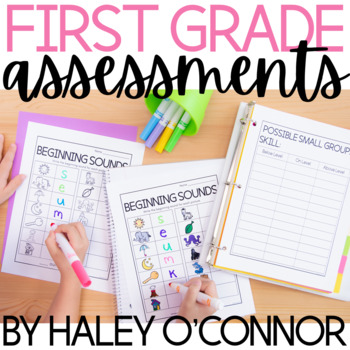First Grade Assessments {Math, Reading, and Phonics}
- PDF
What educators are saying
Description
This resource is printable. If you're looking for the digital version, you can find that here.
These assessments were created to help you maximize time and improve your instruction. The more we know about our student's current level of understanding, the more we can tailor our lessons to their needs.
They were created with the beginning of first grade in mind. However, after thousands of teachers asked for "more," this pack grew to include middle and end of the year standards as well. Each assessment has a "number correct" space on the bottom and a tracking page. You can use these pages to make each student as "below level," "on level" or "above level." Because each district and state is different, this is something you'll want to discuss with whoever you plan with or use your state standards as a guide.
There are two types of assessments in this resource. For some of the assessments, students will just need to identify/recognize the words or numbers. For the other assessments, they will have to generate the answer on their own.
If the assessments use clipart, I've included a color and a black and white version. You might choose to play the colored version in a sheet protector for multiple students to use as a sort of "quick check" or "exit" when a mini-lesson is over. The black and white copies provide great documentation for showing a student's growth or areas of need. Currently, each one of these standards comes with one assessment.
The preview shows every page of this resource. Please download for a closer look.
Phonics
Alphabet
Beginning Sounds
Medial Sounds
Ending Sounds
Digraphs (beginning and ending)
CVC Words
Silent E
Initial Blends
Long Vowels
R-Controlled Vowels
Language Arts
Writing (includes a rubric)
Reading Comprehension (includes a rubric)
Inferences (includes a rubric)
Reading Simple Sentences
Math
Number Recognition (within 100)
Counting to 20 (written)
Counting to 50 (written)
Counting to 100 (written)
Counting to 120 (written)
Ten Frames
Twenty Frames
Counting Objects
Shape Patterns
Addition within 10 (includes a rubric)
Addition within 20 (includes a rubric)
Subtraction within 10 (includes a rubric)
Subtraction within 20 (includes a rubric)
Story Problems (includes a rubric)
Bar Graph
Comparing Numbers
Ordering Numbers
Tens and Ones (with place value blocks)
Place Value
Expanded Form
2D Shapes
3D Shapes
The following pages can be used in two ways.
1. Use the word lists I provided to give spelling tests to students. I've included one spelling sheet with 15 spaces so that you can choose the words which are most applicable.
2. Use the word lists as a quick check of their ability to read words with the phonics patterns quickly and accurately.
Word Lists
Sight Words
CVC Words
Silent E
Digraphs
Initial Blends
Long Vowels
R Controlled Vowels





